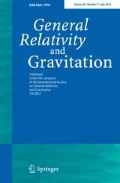Abstract
We consider a Dirac field coupled minimally to the Mielke–Baekler model of gravity and investigate cosmological solutions in three dimensions. We arrive at a family of solutions which exists even in the limit of vanishing cosmological constant.
Similar content being viewed by others
References
Deser, S., Jackiw, R., Templeton, S.: Ann. Phys. (NY) 140, 372 (1982)
Dereli, T., Sarıoğlu, Ö.: Phys. Rev. D 64, 027501 (2001)
Nazaroğlu, C., Nutku, Y., Tekin, B.: Phys. Rev. D 83, 124039 (2011)
Banados, M., Teitelboim, C., Zanelli, J.: Phys. Rev. Lett. 69, 1849 (1992)
Mielke, E.W., Baekler, P.: Phys. Lett. A 156, 399 (1991)
Garcia, A.A., Hehl, F.W., Heinicke, C., Macias, A.: Phys. Rev. D 67, 124016 (2003)
Blagojevic, M., Vasilic, M.: Phys. Rev. D 68, 104023 (2003)
Mielke, E.W., Maggiolo, A.R.: Phys. Rev. D 68, 104026 (2003)
Obukhov, Y.N.: Phys. Rev. D 68, 124015 (2003)
Blagojevic, M., Cvetkovic, B.: Phys. Rev. D 80, 024043 (2009)
Hehl, F.W., Datta, B.K.: J. Math. Phys. 12, 1334 (1971)
Trautman, A.: Bull. Acad. Polon. Scie. 20, 185, 503, 895 (1972).
Hortacsu, M., Özçelik, H.T., Özdemir, N.: \(2+1\) dimensional solution of Einstein Cartan equations. arXiv:0807.4413
Dereli, T., Özdemir, N., Sert, Ö.: Einstein-Cartan-Dirac theory in (1+2)-dimensions. arXiv:1002.0958.
Pronin, P. I., Sardanashvily, G.: Gravity, Particles and Space-time, p. 217. World Scientific, Singapore (1996)
Saha, B.: Phys. Rev. D 74, 124030 (2006)
Watanabe, T.: Dirac-field model of inflation in Einstein-Cartan theory, arXiv:0902.1392.
Hearn, A.C.: REDUCE user’s manual version 3.8 (2004). http://www.reduce-algebra.com/docs/reduce.pdf
Schrüfer, E.: EXCALC: A system for doing calculations in the calculus of modern differential geometry (2004). http://www.reduce-algebra.com/docs/excalc.pdf
Goenner, H., Müller-Hoissen, F.: Class. Quantum Gravit. 1, 651 (1984)
Banerjee, R., Gangopadhyay, S., Mukherjee, P., Roy, D.: JHEP 1002, 075 (2010)
Santamaria, R.C., Edelstein, J.D., Garbarz, A., Giribet, G.E.: Phys. Rev. D 83, 124032 (2011)
Seitz, M.: Class. Quant. Grav. 2, 919 (1985)
Dimakis, A., Muller-Hoissen, F.: J. Math. Phys. 26, 1040 (1985)
Baekler, P., Seitz, M., Winkelmann, V.: Class. Quantum Gravit. 5, 479 (1988)
Dereli, T., Tucker, R.W.: Phys. Lett. A 82, 229 (1981)
Author information
Authors and Affiliations
Corresponding author
Appendix: Irreducible decompositions
Appendix: Irreducible decompositions
In this section we give briefly the irreducible pieces of torsion, contortion and curvature in three dimensions. Firstly torsion which has nine components can be decomposed
where \({}^{(2)}T^a = - \frac{1}{2} (\iota _b T^b) \wedge e^a, {}^{(3)}T^a = \frac{1}{3} \iota ^a (e_b \wedge T^b)\) and \({}^{(1)}T^a = T^a - {}^{(2)}T^a - {}^{(3)}T^a\). In this section the notation with the number under a brace is for the number of components of that part. They have the properties, \({}^{(1)}T^a \wedge e_a = {}^{(2)}T^a \wedge e_a =0\) and \(\iota _a {}^{(1)}T^a = \iota _a {}^{(3)}T^a = 0\). Our choice (25) corresponds to
which means \(4=3\oplus 1\). After the solution (32) we are left only with \({}^{(3)}T^{a}\).
Secondly one can decompose the contortion having nine components
where \({}^{(2)}K_{ab}=\frac{1}{2}[e_a \wedge (\iota ^cK_{cb}) - e_b \wedge (\iota ^cK_{ca})], {}^{(3)}K_{ab}=-\frac{1}{6}\iota _{ab} (K_{cd}\wedge e^{cd})\) and \({}^{(1)}K_{ab} = K_{ab} - {}^{(2)}K_{ab} - {}^{(3)}K_{ab}\). They have the properties \(\iota _a{}^{(1)}K^{ab}=\iota _a{}^{(3)}K^{ab}=0\) and \( {}^{(1)}K_{ab} \wedge e^{ab} = {}^{(2)}K_{ab} \wedge e^{ab}=0\). For our case (26) we possess again \({}^{(1)}K_{ab}=0\), but nonzero \({}^{(2)}K_{ab}\) and \({}^{(3)}K_{ab}\), i.e. \(4=3\oplus 1\). Besides after the solution (32) only \({}^{(3)}K_{ab}\) survives.
Finally one can split the curvature with nine components
where \({}^{(2)}R_{ab}=\frac{1}{2}(e_a \wedge \iota _b - e_b \wedge \iota _a)(e^c \wedge R_c), {}^{(3)}R_{ab}=\frac{1}{6} R e_{ab}\) and \({}^{(1)}R_{ab} = R_{ab} - {}^{(2)}R_{ab} - {}^{(3)}R_{ab}\) with \(R_a = \iota ^bR_{ba}\) and \(R=\iota ^aR_a\). They have the properties \(\iota _{ab}{}^{(1)}R^{ab}=\iota _{ab}{}^{(2)}R^{ab}=0, {}^{(1)}R_{ab} \wedge e^b = {}^{(3)}R_{ab} \wedge e^b=0\) and \(e_b \wedge \iota _a {}^{(1)}R^{ab}=0\). For the solution (32) although all three pieces of curvature and of torsion are nonzero, since \(DT^a =0\) the Ricci tensor is symmetric.
Rights and permissions
About this article
Cite this article
Sert, Ö., Adak, M. Dirac field in topologically massive gravity. Gen Relativ Gravit 45, 69–78 (2013). https://doi.org/10.1007/s10714-012-1460-2
Received:
Accepted:
Published:
Issue Date:
DOI: https://doi.org/10.1007/s10714-012-1460-2


